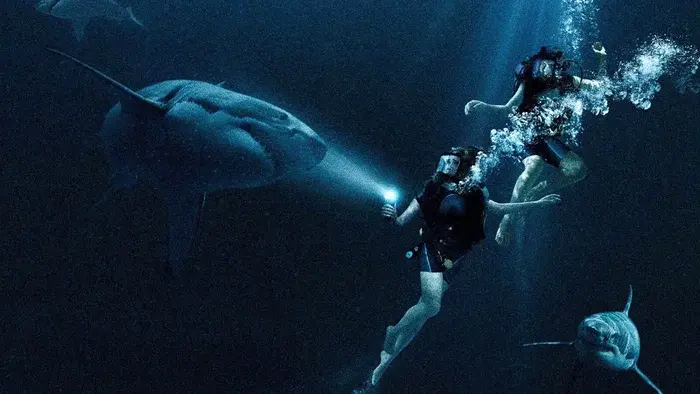The underwater survival thriller 47 Meters Down: Uncaged (2019) takes viewers into the terrifying world beneath the ocean’s surface, combining claustrophobic settings with primal fears of the unknown. Directed by Johannes Roberts, the film is a standalone sequel to 47 Meters Down (2017), but this time the story abandons the shark cage and ventures into an ancient underwater labyrinth.

Plot Overview
The film follows four teenage girls—Mia (Sophie Nélisse), Sasha (Corinne Foxx), Alexa (Brianne Tju), and Nicole (Sistine Stallone)—who decide to explore a hidden underwater Mayan city. Their adventure soon turns deadly when they realize the labyrinth is inhabited by blind, evolved sharks that hunt by sound. Trapped in narrow caves with dwindling oxygen, the group must navigate both natural obstacles and relentless predators while racing against time to survive.
Themes and Atmosphere
Unlike traditional shark-attack thrillers, 47 Meters Down: Uncaged emphasizes claustrophobia and isolation. The submerged ruins create a haunting, maze-like environment where danger lurks at every turn. Themes of friendship, courage, and survival drive the story, while the film plays on primal fears—darkness, drowning, and being hunted.
The movie also explores family dynamics, particularly between Mia and her stepsister Sasha, who must put aside differences and rely on each other in life-or-death moments. This emotional undercurrent adds depth to what could otherwise be a straightforward survival tale.
Cinematic Style
The film makes strong use of underwater cinematography, with dimly lit ruins, echoing sounds, and sudden bursts of terror. Director Johannes Roberts crafts an environment where the characters’ every breath echoes, heightening tension. The sharks themselves, though computer-generated, are designed to appear both familiar and eerily adapted to their cavernous environment.
The score further amplifies the suspense, using sharp tonal shifts to mirror the characters’ rising panic. While the film occasionally dips into predictable jump scares, it maintains a steady sense of dread throughout.
Reception
47 Meters Down: Uncaged received mixed reviews from critics. Many praised its setting and tense atmosphere, while others criticized its reliance on genre clichés and predictable scares. However, audiences generally found it to be an entertaining survival thriller, especially for fans of shark movies. Despite not achieving blockbuster status, the film carved out a niche as a fun, adrenaline-fueled summer release.
Conclusion
While not groundbreaking in its storytelling, 47 Meters Down: Uncaged succeeds in delivering an immersive underwater horror experience. Its unique setting, coupled with the primal fear of being trapped and hunted, makes it a notable entry in the survival-horror genre. For viewers seeking a blend of thrills, suspense, and deep-sea terror, the film is a worthy dive into cinematic danger.
The underwater survival thriller 47 Meters Down: Uncaged (2019) takes viewers into the terrifying world beneath the ocean’s surface, combining claustrophobic settings with primal fears of the unknown. Directed by Johannes Roberts, the film is a standalone sequel to 47 Meters Down (2017), but this time the story abandons the shark cage and ventures into an ancient underwater labyrinth.
Plot Overview
The film follows four teenage girls—Mia (Sophie Nélisse), Sasha (Corinne Foxx), Alexa (Brianne Tju), and Nicole (Sistine Stallone)—who decide to explore a hidden underwater Mayan city. Their adventure soon turns deadly when they realize the labyrinth is inhabited by blind, evolved sharks that hunt by sound. Trapped in narrow caves with dwindling oxygen, the group must navigate both natural obstacles and relentless predators while racing against time to survive.
Themes and Atmosphere
Unlike traditional shark-attack thrillers, 47 Meters Down: Uncaged emphasizes claustrophobia and isolation. The submerged ruins create a haunting, maze-like environment where danger lurks at every turn. Themes of friendship, courage, and survival drive the story, while the film plays on primal fears—darkness, drowning, and being hunted.
The movie also explores family dynamics, particularly between Mia and her stepsister Sasha, who must put aside differences and rely on each other in life-or-death moments. This emotional undercurrent adds depth to what could otherwise be a straightforward survival tale.
Cinematic Style
The film makes strong use of underwater cinematography, with dimly lit ruins, echoing sounds, and sudden bursts of terror. Director Johannes Roberts crafts an environment where the characters’ every breath echoes, heightening tension. The sharks themselves, though computer-generated, are designed to appear both familiar and eerily adapted to their cavernous environment.
The score further amplifies the suspense, using sharp tonal shifts to mirror the characters’ rising panic. While the film occasionally dips into predictable jump scares, it maintains a steady sense of dread throughout.
Reception
47 Meters Down: Uncaged received mixed reviews from critics. Many praised its setting and tense atmosphere, while others criticized its reliance on genre clichés and predictable scares. However, audiences generally found it to be an entertaining survival thriller, especially for fans of shark movies. Despite not achieving blockbuster status, the film carved out a niche as a fun, adrenaline-fueled summer release.
Conclusion
While not groundbreaking in its storytelling, 47 Meters Down: Uncaged succeeds in delivering an immersive underwater horror experience. Its unique setting, coupled with the primal fear of being trapped and hunted, makes it a notable entry in the survival-horror genre. For viewers seeking a blend of thrills, suspense, and deep-sea terror, the film is a worthy dive into cinematic danger.






